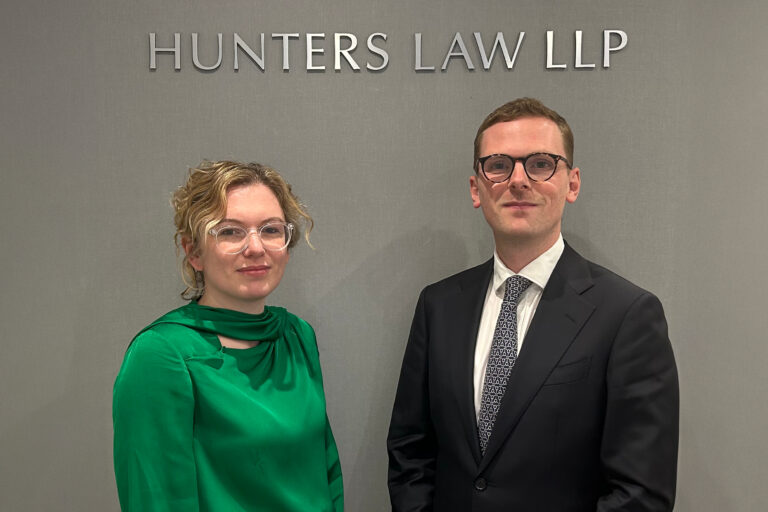Henry Hood and Anna Roiser examine the new transparency pilot in the family court

Henry and Anna’s article was published in Solicitors Journal, 13 February 2024, and can be found here.
Transparency pilot commences in the family court
The ‘Transparency Reporting Pilot for Financial Remedy Proceedings’, launched on 29 January, marks a significant milestone in Sir Andrew McFarlane’s mission to restore public confidence in the family justice system. Increasing transparency in the family court has been a major focus of his tenure as President of the Family Division. Under the pilot, reporters will be able not only to attend hearings relating to financial claims arising on divorce, but also to access case documents and report on the proceedings on an anonymised basis. Whilst this may seem unremarkable to civil and criminal lawyers, it represents a major shift in the world of family law – albeit not as substantial a shift as appeared probable at one point.
The default position under the Family Procedure Rules 2010 is that family proceedings are heard in private, meaning that the general public are not entitled to attend. Since 2009, accredited members of the press have been permitted to attend most family hearings, and in 2018 this was extended to ‘legal bloggers’ (duly authorised lawyers attending for journalistic, research or public legal educational purposes). However, they are not entitled to see case documents, rendering it difficult for them to understand the case. Further, unless granted specific permission by the judge, their ability to report on the proceedings is limited. In respect of proceedings relating ‘wholly or mainly to the maintenance or upbringing of a minor’, the publication of information relating to the proceedings is rendered a contempt of court by s12 of the Administration of Justice Act 1960. The position in respect of financial cases is less clearcut, but caselaw has established that financial information obtained from the parties under compulsion may not be published without leave of the court. Further, financial remedy judgments are routinely anonymised (unless, exceptionally, there is a particular reason to name the parties, such as poor conduct or public interest), and topped with a rubric stating that anyone failing to comply with the condition of anonymity would be in contempt of court. It is unsurprising, in these circumstances, that press attendance at family hearings remains low, though a few committed journalists have attended hearings and successfully sought permission to publish details of the cases.
The stage for change was set in Sir Andrew’s groundbreaking report, Confidence and Confidentiality, published in October 2021. However, the debate on transparency in family proceedings goes back much further – the report opens by acknowledging that it has been a live issue ‘for at least three decades’ but that the pace of change has been ‘glacial’. The difficulty, as Sir Andrew identified, is the presence of two competing public interests: the public has a ‘strong legitimate interest in understanding the work of the [family] court and knowing if it is being done well’, whilst the parties to family proceedings have a ‘natural desire… not to have details of their private lives made public’ – a factor he considered particularly weighty in proceedings involving children. Notwithstanding this, the President recognised that change was required as the status quo did not allow effective public scrutiny of the family court, resulting in a loss of public confidence in it. Whilst it was clear that, in cases relating to for children, this openness would involve anonymisation, this was less obvious for cases relating to financial provision on divorce.
On the same date as Sir Andrew’s Report was released, a consultation document was published on transparency in the Financial Remedy Court (FRC, that part of the family court which hears claims relating to financial provision on divorce). The consultation, authored by Mr Justice Mostyn and His Honour Judge Hess, as the FRC’s lead judges, proposed that reporters be entitled to see a range of case documents containing the parties’ key financial information to enable them to understand the case, and be permitted to publish – without anonymisation – broad descriptions of the parties’ assets, liabilities, incomes and other financial resources, and broad descriptions of the parties’ open positions. The proposed ‘reporting permission order’ explicitly permitted the publication of the parties’ names and photographs and quotes from their witness statements and oral evidence. It also provided for the reporter to be provided by the parties, upon request, with any documents filed in the case which were necessary to enable the reporter to comprehend the factual, evidential or legal issues in the proceedings.
Many financial remedy professionals supported increased transparency but were concerned by the proposals. It was widely considered that they paid insufficient regard to the parties’ right to privacy whilst unlikely to significantly enhance public understanding of the court’s approach to financial remedy cases. Many professionals expressed their concerns in responses to the consultation, our firm included. We suggested that identifying the parties, whilst permitting only ‘broad descriptions’ of the financial arrangements, would not significantly enhance public understanding of the operation of FRC, whereas preserving anonymity but allowing more detailed financial information to be published would do so, whilst also protecting the parties’ privacy. We highlighted that many people are vulnerable following the end of their marriage, and that the prospect of their financial situation becoming public knowledge may intensify their stress. After all, many people prefer not to discuss their financial situation even with close friends and family. We also flagged the risk of one party using the other’s fear of publicity as leverage in negotiations. Resolution, the association of family law solicitors, also raised concerns, including about the impact on children of having their parents’ names, photographs and financial information published; that the proposed terms may incentivise non-disclosure and thereby increase costs; that requiring the release of financial disclosure to journalists would raise GDPR issues; and highlighting the risk of satellite litigation at a time when the court’s resources are already stretched.
Whilst the consultation was ongoing, Mostyn J (who, as noted above, was one of the consultation’s authors), published the first in a string of judgments challenging, from a legal, rather than a policy, perspective, the practice of anonymisation and the prohibition on reporting in financial remedy cases.
In two judgments published in November 2021, Mostyn J challenged the practice of anonymising financial remedy judgments prior to publication. In BT v CU [2021] EWFC 87 he explained ‘I no longer hold the view that financial remedy proceedings are a special class of civil litigation justifying a veil of secrecy being thrown over the details of the case in the court’s judgment’. The following week in A v M [2021] EWFC 89, Mostyn J noted the surprise caused by his approach in BT v CU, recording that ‘views have been expressed that I have snatched away an established right to anonymity in such judgments… I do not believe that there is any such right’, arguing that it was a relatively recent, and unwarranted, innovation. Whilst in these cases Mostyn J agreed to anonymise the judgments based on the parties’ reasonable expectation of anonymity, he warned that going forward his default position would be to publish financial remedy judgments without anonymisation. Whilst he was true to his word, other judges did not generally follow suit.
In April and June 2022 Mostyn J attacked an even more fundamental aspect of privacy – the confidentiality of the proceedings – in his judgments in Xanthopoulos v Rakshina [2022] EWFC 30 and Gallagher v Gallagher (No.1) (Reporting Restrictions) [2022] EWFC 52. Acknowledging that his conclusions were contrary to his previous judgments and the premise of the transparency consultation, he held (following lengthy historical exposition) that the publication of information about financial remedy proceedings is lawful unless the court has ordered otherwise. Thus, absent a contrary order, a reporter attending a hearing may publish anything they see or hear, and the parties, whilst unable to share documents disclosed under compulsion, could talk to whomever they wished about the hearing. Further, an order restricting reporting, or providing for anonymisation, could only be made following an ‘intensely focussed’ balancing exercise leading to the conclusion that privacy should overreach the ‘ancient principle’ of open justice. This would, he said, be exceptional. Whilst the judgments generated much consternation and debate within the profession, the judiciary once again declined to follow Mostyn J’s lead.
This is how the position remained when, in May 2023, the Final Report of the Financial Remedy sub-group of the Transparency Implementation Group was published. The report focused on policy and did not address Mostyn J’s legal arguments, though acknowledged that the legal uncertainty was ‘far from ideal’. In a significant departure from the November 2021 consultation document, and in contrast to Mostyn J’s approach, the committee recommended retaining anonymity in financial remedy cases, with reporters attending hearings entitled to see limited documentation and permitted to report all they see and hear save for certain information which could identify the parties. The pilot program announced in December 2023 (some months after Mostyn J’s retirement) follows this approach. In the end, it takes a very similar approach to the separate pilot scheme established a year earlier in respect of children cases.
The pilot commenced on 29 January 2024 and operates in the Financial Remedy Courts at the Central Family Court in London and in Birmingham and Leeds, to be extended to the Royal Courts of Justice in November 2024. It will apply to three types of financial remedy case covering the bulk of the FRC’s caseload: applications for financial provision on divorce under the Matrimonial Causes Act 1973; applications for financial provision following an overseas divorce under Part III of the Matrimonial and Family Proceedings Act 1984; and applications for financial provision for a child under Schedule 1 of the Children Act 1989 (largely used where the parents were not married). It covers all hearings other than Financial Dispute Resolution hearings, which are. without prejudice hearings designed to enable the parties to reach settlement with judicial assistance. The pilot guidance includes a template transparency order to be made at hearings attended by a reporter, covering access to case documentation for reporters and setting out what they may publish.
The template order provides for a reporter attending a hearing to see each party’s position statement, summarising their perspective on the case (and probably including a summary of the parties’ financial landscape), and the Form ES1, a composite case summary setting out key information including the nature of the issues in dispute and parties’ costs. No other documents may be disclosed without the court’s permission, but the guidance confirms that the reporter may interview the parties, subject of course to their consent. The reporter may publish anything they see or hear, including quotes from documents, save for certain details including: the names, addresses and any photos of the parties and their children; which school any children attend; the parties’ employers, businesses or place of work; the address of any property owned by the parties; the identity of any account or investment held by the parties; the identity of any private company or partnership in which a party has an interest and the names and addresses of witnesses (save for expert witnesses). The parties and the reporter may apply for departures from the template order, and this will be a matter for judicial discretion. However, in a case under the similar provisions of the pilot relating to children cases, Poole J held, in Re BR and others (transparency order: finding of fact hearing) [2023] EWFC 9, that save in exceptional cases the template transparency order would strike the right balance.
The road to this pilot has been long, but we have arrived at the right destination, with a fair balancing of transparency and privacy. Some litigants will feel empowered by the option to share their perspective on their experience of the family justice system in a way that is otherwise prohibited. Others will feel deeply uncomfortable having sensitive issues explored in front of a reporter, aware that family and friends may identify them even in anonymised reports. Where that sense is shared by the parties, arbitration (available in financial remedy cases only since 2012) will offer an appealing alternative. Meanwhile, it is to be hoped that journalists and legal bloggers take advantage of the pilot, and that it will serve its purpose of increasing public confidence in the financial remedy court, dispelling stereotypes and highlighting the tensions and challenges arising from the difficult issues with which the judges must grapple.




